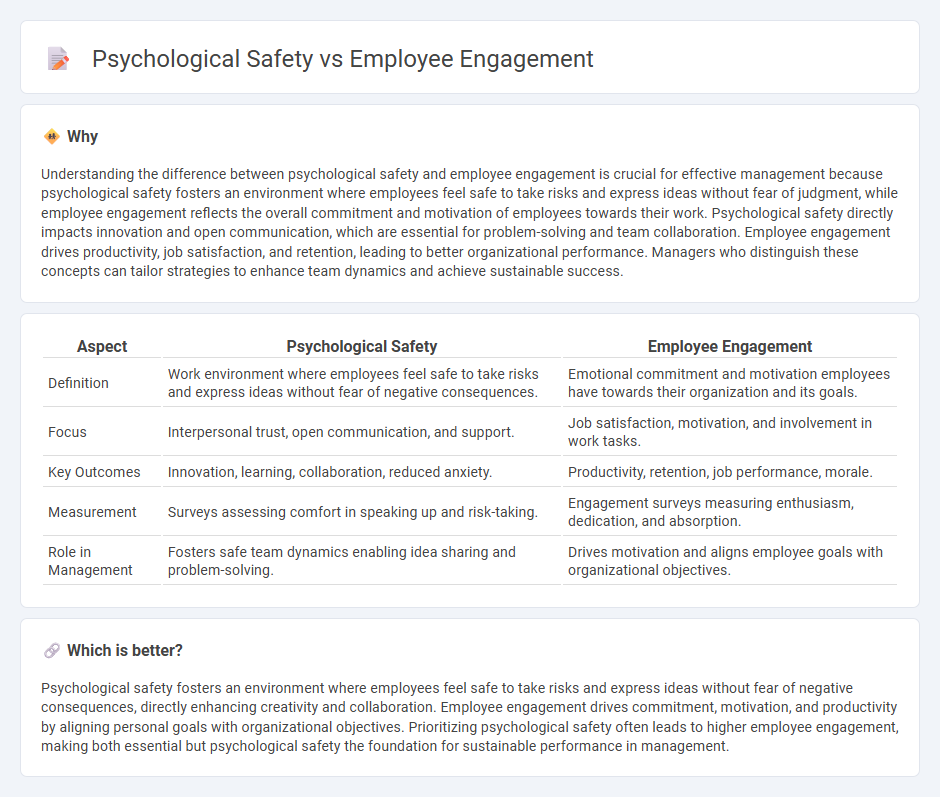
Psychological safety fosters an environment where employees feel secure to express ideas and take risks without fear of negative consequences, directly enhancing employee engagement levels. High psychological safety correlates with increased innovation, collaboration, and overall job satisfaction, driving organizational performance. Explore how integrating psychological safety can transform your employee engagement strategies for sustained success.
Why it is important
Understanding the difference between psychological safety and employee engagement is crucial for effective management because psychological safety fosters an environment where employees feel safe to take risks and express ideas without fear of judgment, while employee engagement reflects the overall commitment and motivation of employees towards their work. Psychological safety directly impacts innovation and open communication, which are essential for problem-solving and team collaboration. Employee engagement drives productivity, job satisfaction, and retention, leading to better organizational performance. Managers who distinguish these concepts can tailor strategies to enhance team dynamics and achieve sustainable success.
Comparison Table
| Aspect | Psychological Safety | Employee Engagement |
|---|---|---|
| Definition | Work environment where employees feel safe to take risks and express ideas without fear of negative consequences. | Emotional commitment and motivation employees have towards their organization and its goals. |
| Focus | Interpersonal trust, open communication, and support. | Job satisfaction, motivation, and involvement in work tasks. |
| Key Outcomes | Innovation, learning, collaboration, reduced anxiety. | Productivity, retention, job performance, morale. |
| Measurement | Surveys assessing comfort in speaking up and risk-taking. | Engagement surveys measuring enthusiasm, dedication, and absorption. |
| Role in Management | Fosters safe team dynamics enabling idea sharing and problem-solving. | Drives motivation and aligns employee goals with organizational objectives. |
Which is better?
Psychological safety fosters an environment where employees feel safe to take risks and express ideas without fear of negative consequences, directly enhancing creativity and collaboration. Employee engagement drives commitment, motivation, and productivity by aligning personal goals with organizational objectives. Prioritizing psychological safety often leads to higher employee engagement, making both essential but psychological safety the foundation for sustainable performance in management.
Connection
Psychological safety fosters an environment where employees feel secure to express ideas and take risks without fear of negative consequences, directly enhancing employee engagement. When workers perceive psychological safety, they demonstrate higher motivation, creativity, and commitment, resulting in improved performance and collaboration. Organizations that cultivate psychological safety experience increased employee satisfaction and reduced turnover, solidifying its critical role in driving active engagement.
Key Terms
Motivation
Employee engagement drives motivation through active participation, commitment, and alignment with organizational goals, enhancing productivity and job satisfaction. Psychological safety creates an environment where employees feel secure to take risks, share ideas, and express concerns without fear of negative consequences, fostering intrinsic motivation and innovation. Explore deeper insights into how motivation thrives at the intersection of employee engagement and psychological safety.
Trust
Employee engagement thrives in environments where psychological safety fosters trust, enabling open communication and collaboration without fear of negative consequences. Trust acts as the foundation for psychological safety, promoting vulnerability and risk-taking that enhance employee motivation and commitment. Explore how building trust can transform your workplace culture and boost overall performance.
Communication
Effective communication plays a crucial role in both employee engagement and psychological safety by fostering trust and openness within the workplace. Clear, transparent dialogue encourages employees to share ideas and concerns without fear of judgment, enhancing collaboration and commitment. Explore more insights on how communication can transform organizational culture and drive performance.
Source and External Links
Why Employee Engagement is Key to Company Success - This article emphasizes the strategic importance of employee engagement in driving productivity, profitability, and long-term retention, highlighting its role in organizational success.
How to Improve Employee Engagement in the Workplace - Gallup provides insights into how employee engagement boosts business outcomes, including higher productivity and customer loyalty, and offers strategies for improvement.
What is Employee Engagement? (And How to Boost It) - This article defines employee engagement as a key indicator of a healthy workplace, where employees feel valued and involved, impacting business outcomes positively.
 dowidth.com
dowidth.com